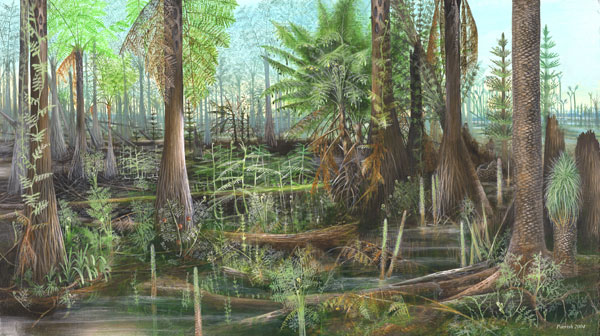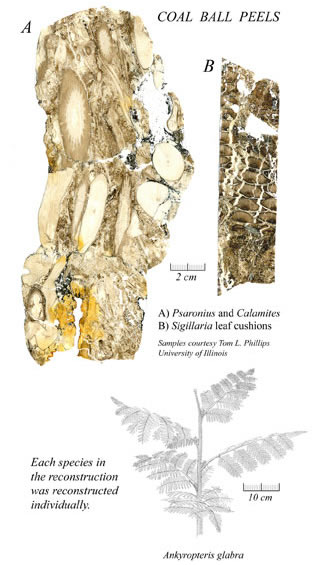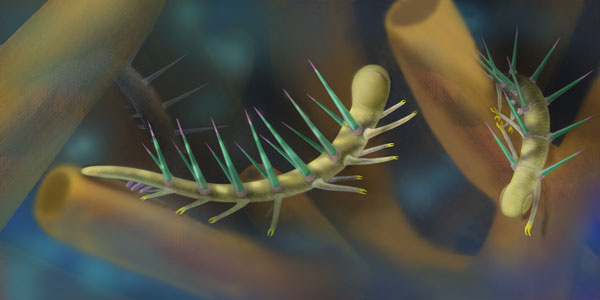Reconstructing an ancient environment
Preparing a full color life restoration of a paleo environment may be the most popular form of paleo illustration both for the artist and the viewer, but it is also the most difficult to do well. This is especially true if the plants and animals in the scene are new to science. Unlike a contemporary landscape that can be copied directly, the ancient environment has to be completely imagined, and yet the artist does not have the freedom to fictionalize the work. A properly done paleo landscape is governed by the data the fossil record provides.
Reconstructing an ancient environment begins with detailed discussions between the artist and scientist. The scientist should provide the artist with reference materials such as specimens, photographs, scientific descriptions, relevant publications and background material, and information regarding the extinct organism's closest living relatives. The scientist should describe their vision of the landscape as thoroughly as possible.

Reconstruction of a Carboniferous (305 million old) coal swamp based on fossil material from the Calhoun coal of Illinois. Illustration by Mary Parrish under the direction of Tom L. Phillips, University of Illinois, and Bill DiMichele, Department of Paleobiology, Smithsonian Institution.Years of study enabled these scientists to interpret the information preserved in the peels and imagine the way the ancient forest looked 305 million years ago.
 |
|
The coal ball peels to the left are samples of the fossil material used to prepare the reconstruction above. Coal balls are concretions, largely of calcium carbonate, which precipitated in ancient peat beds, thus preserving much anatomical structure of the original plants in the coal swamps. Coal ball peels are prepared by slicing the coal ball with a lapidary saw, etching the cut and smoothed surface with hydrochloric acid, and applying a sheet of cellulose acetate to the etched surface with acetone which embeds the fossil cell walls to the cellulose acetate. When dry, the cellulose acetate is pulled from the coal ball and the peel is ready for study.
Part of Tom Phillips' coal ball storage warehouse is seen in the photograph below.

|
Next, the artist should visualize the scene as a whole, and jot down ideas using simple thumbnail sketches. Basic design decisions are developed at this point, including how the eye will travel around the illustration, where the lights and darks will appear, what viewpoint the illustration will take (bug's eye view? pterosaur's eye view?), whether the illustration will focus on a close-up or broad landscape, the time of day, the weather, what the animals will be doing, and so forth. All of these things should be decided upon in consultation with the scientist before a great deal of time is spent drawing. The author gives the final approval on every aspect of the illustration. It is best to receive approval at several stages along the way because the farther along an illustration progresses, the more difficult it is to make changes.
Artists preparing reconstructions should spend as much time as possible sketching and observing nature in the field. In order for a reconstruction to appear natural, an artist needs to include both new and old growth on plants, leaf litter and debris on the ground, and other signs of the process of life and death. While the ancient world differs greatly from the modern one, the modern world is our only analogue, and is therefore still our a good resource for information.
Each plant or animal represented in the scene must be individually reconstructed. If working on a plant, this begins with reconstructing the leaf. If working on a vertebrate fossil, the beginning could be the reconstruction of individual bones in a skeleton. Attention to scale (or relative size) from one plant or animal to the next is important. Once the plant or animal is well understood, it can be posed for the reconstruction.
There is no way of knowing the color that most extinct plants and animals were in life. Usually artists and scientists base their colors on those of the closest living relatives, but a great variety of colors and patterns appear in paleo reconstructions. Soft parts, such as ears, are also open to interpretation. It can be very difficult to make decisions based on incomplete data, yet there should be a reason behind every decision that is made whenever possible.

This reconstruction shows Hallucigenia, one of the 505 million year old fossils from the Burgess Shale of Canada, crawling over the fossil sponge from the same locality, Vauxia. Although many marine invertebrates are brightly colored, as this illustration shows, the colors selected for the animal in this painting reflect the name of the animal and the artist's imagination rather than data left by the fossil record. Illustration by Mary Parrish for Doug Erwin.
After individual sketches have been approved by the scientist, a pencil sketch of the entire scene should be prepared. There is a limit to the number of changes and corrections that can be made in a painting before it begins to look tired and labored. To be fresh and well executed, all decisions should be made prior to beginning the final painting. This may necessitate preparing study paintings to work out aspects such as color mixing, proper light, and perspective.
When a sketch of the complete scene is approved, the artist can begin to render the final art.
When the painting is finished, it should be digitized for reproduction. Last minute corrections can be made on the digital file if needed.
It can take take several months and many consultations to finish a complex paleo reconstruction for a careful scientist who cares about the many details of each plant, animal and aspect of the landscape represented in the illustration.
Life restorations of fossil vertebrates
The best way to reconstruct fossil vertebrates is to start by determining what modern animal (or animals) the fossil animal is most closely related to and studying everything about this creature from its life habits to its skeletal anatomy and musculature. The artist should begin by putting the fossil skeleton together, which often necessitates first reconstructing individual bones of the skeleton themselves that may be broken or even missing.
This process is followed by reconstructing the musculature of the animal preferrably done by studying and dissecting modern animals and analyzing muscle attachment scars on the fossil bones. Tendons, veins and arteries are added, followed by fur, skin, or scales. A brief but good description of this process can be found on page thirty of David Norman's book: The Illustrated Encyclopedia of Dinosaurs.
The next step is to make many sketches of the fossil animal to pose the animal as it would appear in life. After a final pose has been decided, it can be useful to build a clay model to copy. This way the animal can be properly lit and photographed, so the artist has a three-dimensional figure to copy.
Reconstructing fossil plants
Reconstructing fossil plants is even more challenging than reconstructing fossil vertebrates. Vertebrates have similar skeletal frames, even though they can be very different in shape. Plant morphology is much more varied, complex, and unpredictable. Plants often are more likely to be preserved in fragmentary pieces than as a whole plant. How should a fossil leaf attach to its stem? Is the leaf from a shrub or a tree? These are often difficult, if not impossible questions to answer, even for expert paleobotanists.
Reconstructing fossil invertebrates
Invertebrates such as crabs or mollusks usually only preserve their shells and other hard parts. Soft-bodied invertebrates (such as jellyfish, anemones or tunicates) are even more rarely preserved in the fossil record. Occasionally, life restorations are even based on trace fossils, such as tracks, trails, or the insect damage left on fossil leaves, stems and tree trunks.
|